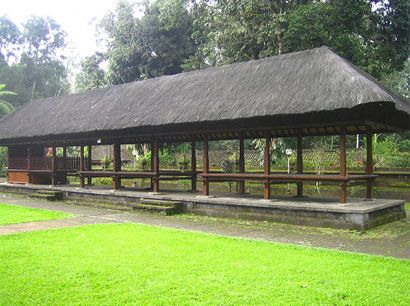Birthdays, weddings, and temples festivals are all occasions for dramatic performances and dance is inextricably linked with the Balinese religion. Through this medium, people learnt about the tales of the Ramayana, Mahabrata and other epic stories from Balinese history.
Barong and Rangda dance
This is basically a story about the struggle between good and evil. Good is personified by the Barong Keket, a strange, fun-loving creature in the shape of a shaggy semi-lion. Evil is represented by Rangda, a witch. Ultimately, the two characters engage in battle, at which point the Barong's keris-bearingRata Kiri Kanan follower rush in to attack Rangda. The witch, however, uses her magical powers to turn the keris knives in upon their owners, who fall into a trance and start trying to stab themselves. The Barong uses magic to protect his followers from the knives. In the end, the Barong triumphs and Rangda retreats to recuperate her strength for the next encounter. All that remains is for a priest to help the keris dancers out of their trance, with the help of a little holy water. The Barong and Rangda dance is a very powerful performance and is not taken lightly by those involved.
Kecak Dance
The Kecak is an unusual Balinese dance for a couple of reasons. First, there is no musical accompaniment. The gamelan is not there. Rhythm is provided by a chanting 'monkey' chorus. The polyrhythmic sound of the chanting provides the name, 'Kecak'. The story line for the Kecak is taken from the Ramayana. Prince Rama goes hunting for a golden deer and his beautiful wife is kidnapped by the evil Rawana. Story is secondary in this performance, though. If you want to see the story of the Ramayana, you should see a Ramayana performance. The Kecak is a triumph of style and mood, rather than story. Watch the faces of audience members. More than any other Balinese dance, the Kecak turns every viewer into a child, wide-eyed and transfixed.
Legong Dance
The story derives from the history of East Java in the 1 2th and 1 3th centuries: when on a journey the King of Lasem finds the maiden Rangkesari lost in the forest. Rangkesari's brother. Prince Daha, gathers an army together to rescue his sister. Princess Rangkesari then tries to persuade Laksmi to let her go to avoid a war, but he denies her her freedom. On his way to battle, Daha is attacked by a raven, a bad omen, and is later killed in battle. The dance only takes the story up to the point where the king departs for battle, and it is performed by three people, two Legongs and their attendant, the "Condong". The Legong is a very classical and graceful dance, and is always performed by pre-pubescent girls, often as young as eight or nine years old.
Baris Dance
A warrior dance for a group of a dozen or middle age men, its purpose is to protect the visiting gods at temple festival from evil spirits. The dancers wear headdresses with a triangle of white clothe at the back. This dance requires great skill, with the artist having to display the whole range of inner emotions, mainly through facial expression.
Shanghyang Trance Dance
The Sanghyang is a divine force that enters the bodies of the entranced dancers. There are a number of dances, but the most common are the Sanghyang Dedari and the Snghyang Jaran. The Sanghyang Dedari is performed by two girls, and is very similar in style to the Legong; the main difference is that the Sanghyang Dedari girls are supposedly untrained and can keep in perfect time with each other, even though their eyes are firmly shut. The accompanying music is provided by a female choir and a male Kecak choir.
In the Sanghyang Jaran, a boy dances around and through a fire, riding a coconut palm hobbyhorse. This is a frequently called the "Fire Dance", for the sake of tourists. In both dances, a priest is always on hand to help bring the dancers out of their trance-state at the end of the performance.
Calon Arang
An exorcism drama aimed at the local village witches (leyak, celuluk) and performed when a new temple is dedicated.The part of rangda is taken by an experienced older aktor becouse the performance involves the witch going into an entrance rage, possessed so Balinese believe by the spirit of the actual Rangda. The end of this even id unpredictable and a Rangda can occasion run amok. The purpose of the performance is to placate the rangda by demonstrating her power, and thus gain her co-operation against the lesser witches in the village.
Mask Dance
In Bali, masks are considered sacred objects, and are revered as such. The best ones are traditionally carved on auspicious days, and the dancers who wear them are believed to be possessed by the spirits of the masks. Characters can be identified from the shape of the features; noble characters always wear full, refined masks; while evil is represented by bulging eyes and garish colours. The characters are silent, but communicate using complex gestures of the hand, head and body. The story lines usually follow popular myths, or episodes from history.
source:bali-travels.blogspot.com


















